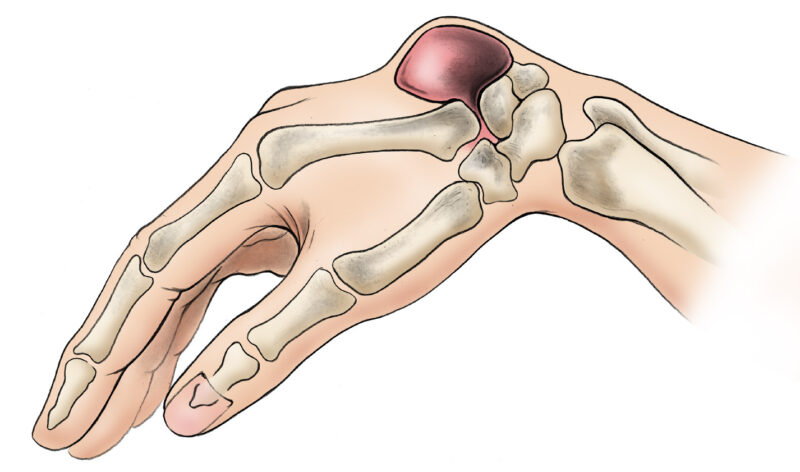A ganglion cyst is a small, starchy, or translucent sac filled with fluid that grows on the joints or tendons. Though they can develop on the foot, ankle, and knee, they are most likely to appear on the back, wrist, and hand.
A ganglion cyst may be painful and irritating, but most of the time, they are painless and generally harmless.
In this article, you will explore whether a deficiency of vitamins contributes to the formation of ganglion cysts or if vitamin deficiency is not a contributing factor.
Causes and Risk Factors
Though the exact cause and effect of ganglion cysts are still unknown, several factors are believed to contribute to their development:
- Injuries and Overuse: Individuals who have suffered injuries or overused a joint are more prone to developing ganglion cysts.
- Repetitive Stress: Repetitive overstress on the joints can lead to the formation of ganglion cysts.
- Rheumatoid Arthritis: People suffering from rheumatoid arthritis are at a higher risk of developing ganglion cysts.
- vitamin D Deficiency: Many studies indicate that a deficiency in vitamin D may significantly contribute to the development of ganglion cysts.
Relation with vitamin D

Vitamin D plays a crucial role in various bodily functions, including immune function, muscle health, and bone health. It is also suggested to be beneficial for joint health and injury prevention.
Research Findings
- 2018 Study: According to a study published in the Dermatologic Surgery Journal, individuals with ganglion cysts are more likely to have a deficiency in vitamin D than those without ganglion cysts. The study indicates that multiple ganglion cysts are more common in individuals with a vitamin D deficiency.
These studies suggest that vitamin D deficiency may play a role in the development and growth of ganglion cysts. However, further research is essential to validate this discovery.
Treatment of Ganglion Cysts

If you suspect you have a ganglion cyst, it is important to consult with your doctor to receive a proper diagnosis and discuss various treatment options. Treatment methods include[2]:
Observation
Most ganglion cysts are harmless and painless, requiring no treatment. Your doctor may advise you to wait and monitor the cyst, especially if it is small, to allow for natural healing.
Aspiration
This process involves inserting a needle into the cyst to remove its fluid. Aspiration is a simple and effective method, but there is a possibility that the cyst may recur.
Surgery
Surgery is usually recommended when other treatments fail, and the cyst causes significant pain and discomfort. The surgeon removes the cyst through an operation, although it is not always a permanent solution, as cysts can recur post-surgery.
Prevention
To reduce the risk of developing ganglion cysts, consider the following precautions[3]:
- Avoid Repetitive Stress: Avoid repetitive stress on your joints.
- Maintain a Healthy Weight: Keeping a healthy weight can reduce joint stress.
- Regular Exercise: Engage in regular exercise to maintain joint health.
- Healthy Diet: Eat a balanced diet rich in nutrients.
- Vitamin D Intake: Ensure you get enough vitamin D from sunlight, food, and supplements.
The National Institute of Health (NIH) recommends 600 IU (international units) of vitamin D daily for adults. Some individuals may require higher doses based on their body’s needs, age, and sun exposure. Consult your doctor to determine your specific vitamin D requirements and whether you need a supplement.

Additional Tips
- Supportive Footwear: Wear supportive footwear and splints as necessary.
- Activity Modification: Take breaks from activities that cause pain.
- Cold and Heat Therapy: Apply ice or heat to inflamed areas to minimize pain.
- Consult a Doctor: If you experience pain or irritation from your cysts, consult a physician.
Further research is needed to confirm the links between ganglion cysts and vitamin D deficiency. While vitamin D supplements are generally safe and well-tolerated, it is important to consult your healthcare provider before starting any supplements.
References
- Kim, J., Park, J., Jee, H., & Oh, S. (2011). Successful treatment of recurrent digital mucoid cysts using a 1,444-nm neodymium-doped yttrium aluminum garnet laser.. Dermatologic surgery: official publication for American Society for Dermatologic Surgery [et al.], 37 10, 1528-30.
- Suen, M., Fung, B., & Lung, C. (2013). Treatment of Ganglion Cysts. ISRN Orthopedics, 2013.
- Zubowicz, V., & Ishii, C. (1987). Management of ganglion cysts of the hand by simple aspiration. The Journal of hand surgery, 12 4, 618-20 .








